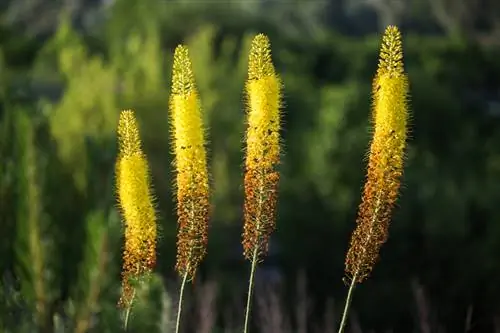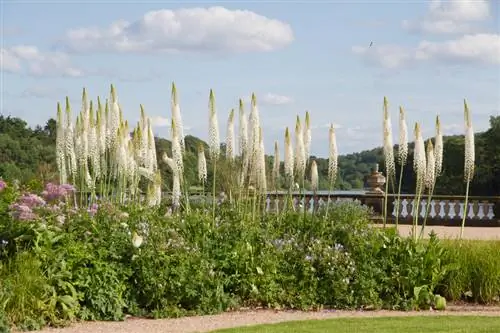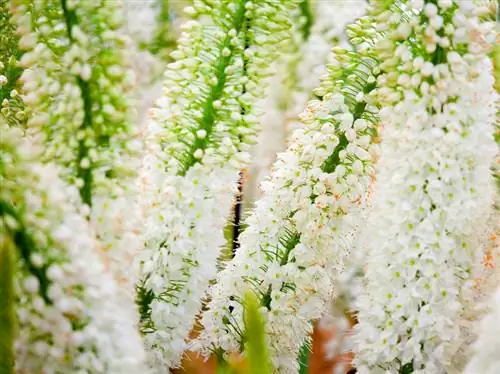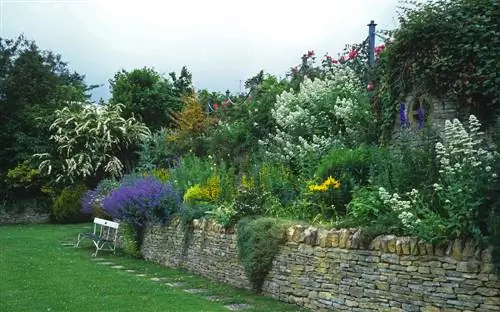- Author admin [email protected].
- Public 2023-12-25 17:45.
- Last modified 2025-01-23 11:22.
The steppe candle gives the perennial bed a decorative structure with a majestic silhouette. As a solitaire with a unique long-distance effect, we cannot escape the magic of an Eremurus. The following answers to frequently asked questions reveal what the royal Cleopatra needle values in its cultivation.
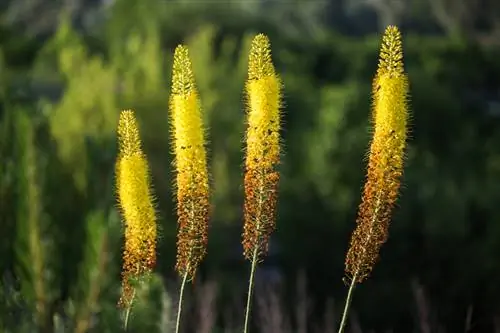
How do you properly care for the steppe candle?
To successfully cultivate the steppe candle, plant it in well-drained, nutrient-rich soil in a sunny location between September and November. Care for them with regular watering, spring fertilization and winter protection using leaves, compost and brushwood.
Planting steppe candles correctly
The professional planting of all Eremurus species and varieties is based on careful soil preparation. Since the starfish-like tubers are quite fragile, loose and deep soil is important. If the soil seems too clayey, if in doubt, add sand or fine grit and some compost. How to plant the steppe candle correctly:
- The ideal planting time is from September to November
- Create a 45-50 cm deep planting pit
- Mix mature compost and horn shavings into the excavation
- Spread a 20 cm high drainage layer of sand or fine gravel on the sole
- Plant the tuber so that its eye is a maximum of 15 cm below the surface of the soil
After the planting site has been watered, spread a layer of leaf mold, compost and coniferous twigs. In this way, winter moisture cannot harm the tubers.read more
Care tips
To manage the care of a furious Eremurus, you do not need to have extensive previous gardening knowledge. After planting, spread a generous layer of mulch to protect the ornamental shrub from the rigors of winter in subsequent years. In spring, the steppe candle gratefully accepts a fertilizer for flower bulbs or a portion of compost with horn shavings. Water the flower when it is dry but without causing waterlogging. You can cut the withered flower candles either immediately after the flowering period or in autumn. Before the first frost, the entire perennial should be cut off close to the ground in order to spread the winter protection mentioned in the form of leaves, straw and brushwood.read more
Which location is suitable?
She is considered a prime example of a sun worshipper. If you give Eremurus a location in full sun, warm and sheltered from the wind, its mighty flower towers will rise above the lanceolate, grass-like foliage. The condition of the soil proves to be no less relevant site condition. The sensitive rhizomes require a loose, not too moist and nutrient-rich substrate.
The correct planting distance
In parks and large gardens, the impressive steppe candle comes into its own in small groups of 3-4 specimens. The ideal planting distance in this case is 50-60 cm, or 4 Eremurus per square meter. If a lily tail acts as a structuring solitaire, we recommend a distance of at least 80 cm from the bed neighbor.
What soil does the plant need?
Pay special attention to the quality of the soil, as this is a central factor for the successful cultivation of Eremurus. This is how the soil should be structured:
- Rich in nutrients
- Humos and profoundly relaxed
- Fresh to slightly sandy and with first-class water drainage
Since nutrient-rich soil tends to have a heavy consistency, if necessary, simply add a few handfuls of sand, fine grit (€12.00 at Amazon) and coarse compost.
What is the best time to plant?
In gardening practice, the months of September to November have proven to be the best possible planting time for Eremurus. At this time, the summer sun has warmed the soil deeply, which encourages rapid rooting before winter. In addition, the steppe candles start their first garden season with a vital growth lead.read more
Cut the steppe candle correctly
The undisturbed Eremurus are allowed to thrive, the more magnificent their impressive silhouette will be. Therefore, cut the ornamental perennial rarely. To use the furious flower candles as decoration for the floor vase, cut them off as soon as the lower buds have opened. The withered flower columns continue to set decorative accents with their seed heads. If it is desired to sow steppe candles in the garden, enjoy this spectacle and only carry out the pruning close to the ground in autumn. Otherwise, first cut off the withered inflorescences and leave the foliage in the bed until it has completely absorbed.
Pouring steppe candle
Where such mighty flower towers rise above a bushy foliage, intensive evaporation understandably occurs. Therefore, water Eremurus regularly in a sunny location when the soil surface has dried out. The ornamental perennials absorb the water best when it is poured from the can spout directly onto the root disk. Ideally, you should administer the irrigation water in sips so that no harmful waterlogging can form.
Fertilize steppe candles properly
With a starter fertilization in spring you give your Eremurus the energy it needs to bloom magnificently. Ideally, you should apply organic fertilizer such as mature compost, horn shavings, guano granules or bark humus. Alternatively, a commercially available fertilizer for flower bulbs can be used as a nutrient supplier.
Wintering
Since the rhizome of an Eremurus lies so close to the surface of the earth, the following precautions make sense for a he althy wintering:
- Cut off the dead leaves and the wilted flower candles in autumn at the latest
- Cover the planting site high with leaves, compost and brushwood
More threatening than bitter frost and winter snow are delayed ground frosts in spring. Keep an eye on the weather forecasts and, if necessary, protect the fresh shoots with garden fleece wrapped several times or pots turned inside out.
Propagate steppe candle
A well-established steppe candle produces daughter tubers from its starfish-like root system that are suitable for propagation. In late summer, dig up the Eremurus to cut off these breeding tubers with a sharp knife. Throughout the winter, care for the offspring in pots with a mix of potting soil and sand so that they develop a vital root system. In late summer, plant the young steppe candles in the loose, nutritious soil in full sun. Alternatively, you can plant the harvested daughter tubers directly in the bed, which is associated with a high risk of failure.
Sowing is another method of propagation. In autumn, remove the seeds from the ripe capsule fruits. Since these are cold germinators, sow the seeds directly in the bed so that they receive the cold stimulus naturally. However, sowing is more successful under controlled conditions behind glass. Stratification paves the way for germination by depositing the seeds in moist sand in the vegetable compartment of the refrigerator for 4-6 weeks.read more
Steppe candle does not bloom
If an Eremurus refuses the longed-for blooms, there are various reasons behind it. The following overview shows common triggers and gives quick tips for resolving them:
- Lack of light: transplant to a full sun location
- Compacted soil: Optimize the soil with sand, fine grit and compost
- Blight caused by waterlogging: Dig up and dispose of
- Frost damage due to ground frost: Protect the first shoots with several layers of garden fleece
If your problem child is a seedling-propagated Eremurus, be patient. After sowing, it takes 3 to 5 years until the first flowering occurs.read more
Beautiful varieties
- Cleopatra: Wonderfully compact variety with orange, red-striped flowers and red midrib; Growth height 125 cm
- Romance: This Eremurus spreads romantic flair with salmon pink flower candles from May to July; Growth height 180 cm
- Himalaicus: Magnificent specimen with milky white, 50 cm long flower spikes and hundreds of individual flowers; Growth height 150 cm
- Yellow Eremurus: Sets accents in the bed with bright flower columns. A wonderful cut flower; Growth height 130 cm
- Pinokkio: Unmissable eye-catcher for the perennial bed thanks to the orange inflorescences; Growth height 100-130 cm

